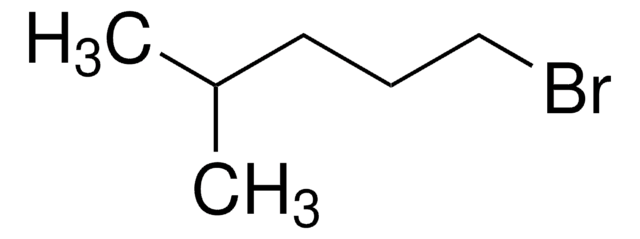493953
5-Methyl-1-hexanol
97%
Synonyme(s) :
5-Methylhexanol
About This Item
Produits recommandés
Pureté
97%
Indice de réfraction
n20/D 1.422 (lit.)
Point d'ébullition
167-168 °C (lit.)
Densité
0.823 g/mL at 25 °C (lit.)
Chaîne SMILES
CC(C)CCCCO
InChI
1S/C7H16O/c1-7(2)5-3-4-6-8/h7-8H,3-6H2,1-2H3
Clé InChI
ZVHAANQOQZVVFD-UHFFFAOYSA-N
Catégories apparentées
Description générale
5-Methyl-1-hexanol is a volatile organic compound found in:
- Alstonia boonei leaves
- ‘Hayward′ and ‘Hort16A′ kiwifruit
- Tuber melanosporum fruiting body
Mention d'avertissement
Warning
Mentions de danger
Conseils de prudence
Classification des risques
Acute Tox. 4 Oral - Flam. Liq. 3 - Skin Irrit. 2
Code de la classe de stockage
3 - Flammable liquids
Classe de danger pour l'eau (WGK)
WGK 3
Point d'éclair (°F)
86.0 °F
Point d'éclair (°C)
30 °C
Certificats d'analyse (COA)
Recherchez un Certificats d'analyse (COA) en saisissant le numéro de lot du produit. Les numéros de lot figurent sur l'étiquette du produit après les mots "Lot" ou "Batch".
Déjà en possession de ce produit ?
Retrouvez la documentation relative aux produits que vous avez récemment achetés dans la Bibliothèque de documents.
Les clients ont également consulté
Notre équipe de scientifiques dispose d'une expérience dans tous les secteurs de la recherche, notamment en sciences de la vie, science des matériaux, synthèse chimique, chromatographie, analyse et dans de nombreux autres domaines..
Contacter notre Service technique












